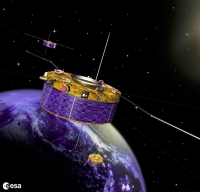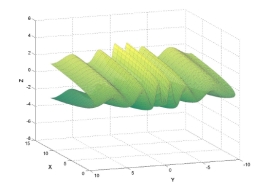
Artist's impression of two of the Cluster spacecraft. Courtesy: ESA
Science Nuggets: Magnetospheric Physics
The wavy plasma sheet
Away from the Sun, the magnetic field of the Earth is drawn out into a long tail (the magnetotail) by the action of the solar wind. This tail consists of magnetic field lines which connect to the Earth's surface in both hemispheres (closed field lines) and those which connect to the Earth's surface at one end and the interplanetary magnetic field at the other (open field lines). Spacecraft observations over many years have shown that the region of closed field lines can oscillate up and down, with large, slow waves travelling from the middle of the tail out towards the flanks.

Model of the flapping plasma sheet. Image adapted from Erkaev et al. (2008)
Recently, Forsyth et al. (2009) re-investigated the first observations of these waves by the Cluster spacecraft. By including data from a variety of other spacecraft at different locations in the magnetotail, including those in geo-stationary orbits and those imaging the aurora, they showed that these waves travel across the tail at the same speed as substorms - a process which drastically reconfigures the magnetic field in the tail. Using new models of these waves, they suggested that the wave speed and the expansion speed of the substorms towards the flanks are controlled by the global magnetic field topology. These results will help scientists to better understand the sources of energy in the magnetotail and the space environment in which we live.
For more details, see:
Forsyth, C.; Lester, M.; Fear, R. C.; Lucek, E.; Dandouras, I.; Fazakerley, A. N..; Singer, H.; Yeoman, T. K.
Solar wind and substorm excitation of the wavy current sheet
Ann. Geophys., 27, 2457-2474 (2009) [Online]